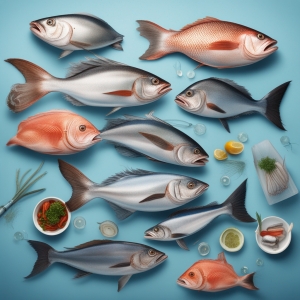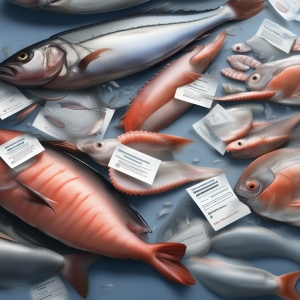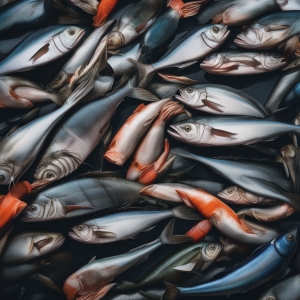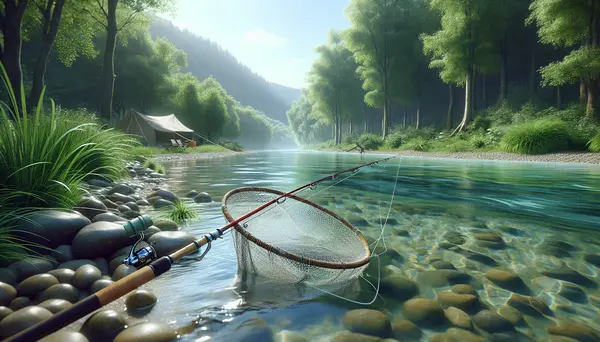Table of Contents:
Intro: A Dive into Sustainable Seafood
Lulled by the soothing sounds of the sea and delighted by the play of colors in the sunset sky, casting your fishing line into the deep blue can be a captivating experience. However, as passionate consumers of the fruits of the sea, it's crucial that we understand our impact on ocean life and the importance of sustainable seafood. This article will dive into the subject of ethical fishing practices and offer guidance on how to make conscious consumer choices that support marine biodiversity.
Choosing sustainable seafood isn't only beneficial for marine life - it also ensures the longevity of the fishing industry and safeguards our enjoyment of seafood. Whether you're a fishing enthusiast, a camping lover cooking up your catch, or a consumer selecting seafood at the market, understanding sustainability can make a significant difference. So, let's navigate through the ocean of information about sustainable seafood together.
I'm afraid there appears to be a miscommunication. Can you please provide me with the specific subheading you wish to be written about? This will allow me to generate a suitable paragraph accurately and informatively.I'm sorry for the confusion, but the provided subheading `','` seems to be incomplete. Could you please provide me with a specific topic or aspect of sustainable seafood, ethical fishing, or consumer choices that you'd like me to elaborate on under this subheading? I'd be happy to help!Es tut mir leid, es scheint, als ob die Unterüberschrift oder das Thema, das du für den Abschnitt möchtest, fehlt. Könntest du bitte spezifischer sein, worüber ich den Abschnitt schreiben soll? Ich muss die spezifische Unterüberschrift oder das Thema wissen, um eine genaue und informative Passage zu entwickeln.Es tut mir leid, es besteht weiterhin Verwirrung. Die Angabe für die Subüberschrift ist ungültig. Könnten Sie erneut die Subüberschrift eingeben?
Understanding Ethical Fishing Practices
Ethical fishing is about more than just catching fish - it's a broad concept that underscores the importance of ecological balance and long-term conservation efforts. To truly understand ethical fishing practices, it's helpful to look at a few essential parameters that define it.
The method used to catch fish is one crucial factor in ethical fishing. High-impact methods such as dredging and trawling, which can often be harmful to the marine ecosystem, are less desirable than low-impact techniques like line and pole fishing. Reducing bycatch - the unintended capture of non-target species - is also an essential part of ethical fishing.
Another important part of ethical fishing is adhering to regulations and quotas. Overfishing and illegal fishing pose major threats to our oceans and can have a devastating effect on species populations.
Lastly, ethical fishing also involves caring for the quality of the sea-life habitat, which means opposing practices that contribute to pollution and degradation of our oceans.
It's clear that stepping up our ethical fishing game can have a great impact on marine conservation efforts, so let's see how we, as consumers, can contribute to this.
Evaluation of Ethical Fishing Practices and Consumer Choices
| Ethical Fishing Practices | Consumer Choices |
|---|---|
|
|
| Cons | Challenges |
|
|
Consumer Choices: Making a Difference

As consumers, we yield a significant ability to influence the fishing industry's practices and to promote sustainable seafood. Making conscious choices at the market and the restaurant can give us a hand at steering the industry towards more sustainable practices. Here are a few tips to make smarter seafood choices that protect our oceans.
Firstly, consider looking for certain labels on seafood products that certify they've been responsibly harvested. Labels like the Marine Stewardship Council (MSC) or the Aquaculture Stewardship Council (ASC) are trustworthy indicators of sustainably caught or farmed seafood. These products often come with a tracking code, enabling you to trace the origins of your seafood.
Secondly, diversify your seafood consumption. Relying excessively on a few popular types might put these species at risk. Opting occasionally for less known but equally delicious alternatives could help ensure a diverse and healthy ocean ecosystem.
Finally, educate yourselves and others around you about sustainable seafood. A more informed consumer base could hugely increase the demand for responsible fishing and farming practices.
In conclusion, each one of us holds a fishing rod of influence over the future of our oceans with our seafood choices. Let's use it wisely!
Sea to Table: The Journey of Sustainable Seafood
The journey of sustainable seafood, from the vast ocean depths to your dining table, is a fascinating one. It's a voyage that intertwines ethics, eco-responsibility, and consumer choices. Let's glimpse at this transformative process.
The journey begins with the choice of fishing method. Ethical fishermen adopt low-impact techniques such as line or pole fishing to minimize disturbance to marine ecosystems and reduce bycatch. Fishing gear is also carefully selected to cause less harm to the marine flora and fauna.
Once the catch is aboard, it's about ensuring adequate storage conditions to maintain the quality and freshness of the fish. Sustainability extends to this aspect as well, with energy-efficiency and reduced carbon footprint being key considerations.
The harvested seafood then reaches processors who adhere to rigorous standards of hygiene and processing methods to maintain the nutritional integrity of the fish. Another fascinating aspect of this journey is the tracking and traceability mechanisms in place, enabled by technologies such as blockchain. This transparency helps consumers make informed choices.
Seafood products are then labelled with certifications like the MSC or ASC, indicating that they've been harvested sustainably. These labeled products then travel to markets, restaurants, and eventually to your plate, completing a journey that has ethical responsibility at its heart.
Bringing sustainable seafood to your table is, therefore, not just a choice but an endorsement of ethical fishing practices and a commitment to marine conservation.
Learning to Read Labels: Looking for Ethical Certifications

One of the easiest and most effective ways to support sustainable seafood is to understand and look out for ethical certifications when purchasing your favourite seafood products. Learning to read labels properly is like acquiring a new language - the language of sustainable consumer choices.
Certification labels such as the Marine Stewardship Council (MSC) and the Aquaculture Stewardship Council (ASC) are key indicators of responsibly sourced seafood. These labels guarantee that the products have met strict standards set for sustainable fishing and farming practices.
The blue MSC label signifies that the seafood product has been harvested via sustainable fishing practices that promote healthy oceans. This includes precautions to prevent overfishing, minimize environmental impact and safeguard marine ecosystems.
The green ASC label assures that the seafood is responsibly farmed. ASC certified farms are committed to protecting local ecosystems and biodiversity, promoting good fish health and welfare, and adhering to a socially responsible management system.
By trusting these certifications, you're not only aiding environmental efforts but also supporting fishing communities that rely upon sustainable practices for their livelihoods.
At first glance, labels can seem complex and overwhelming. But with practice, you'll be fluent in this language of sustainable seafood and making a difference with every seafood purchase.
Fazit: The Bigger Picture of Sustainable Seafood
In the grand scheme of things, sustainable seafood goes beyond individual fishing or consumption choices - it's an issue intertwined with environmental, social, and economic implications. Acknowledging the complex web of life beneath the waves impels us towards a more balanced relationship with our planet, rethinking our attitudes towards seafood and the practices that bring it to our plate.
By promoting ethical fishing practices, we can help ensure the vitality of marine ecosystems and the diverse creatures that populate them. The decisions we make as consumers can significantly influence the state of the world's oceans and our global fishing industry, supporting the livelihoods of millions around the world.
In essence, sustainable seafood is not just about what we eat, but how we respect and protect our fellow Earth inhabitants and future generations' right to experience the incredible richness and beauty of our oceans. The catch, therefore, lies not only in the nets of fishermen but in the choices we make when we're shopping or ordering off a menu. That's a responsibility worth diving deep for.
FAQ about Ethical Seafood Consumption

What is sustainable seafood?
Sustainable seafood refers to seafood that is caught or farmed in ways that consider the long-term vitality of harvested species and the well-being of the oceans, as well as the livelihoods of fisheries-dependent communities.
Why is sustainable seafood important?
Sustainable seafood is important for maintaining healthy oceanic ecosystems. Overfishing, illegal fishing, and harmful fishing practices can lead to depleting stocks, destruction of habitats and endangering of marine species.
How can consumers make sustainable seafood choices?
Consumers can make sustainable seafood choices by buying from certified sustainable fisheries, seeking out local and seasonal seafood, and diversifying the types of seafood they consume to reduce pressure on overfished species.
What are the traits of ethical fishing practices?
Ethical fishing practices involve limiting bycatch (the unintentional capture of non-target species), avoiding destructive fishing techniques, managing fish stocks effectively to prevent overfishing, and ensuring the welfare and fair treatment of fishery workers.
How do sustainable seafood labels work?
Sustainable seafood labels like Marine Stewardship Council (MSC) and Aquaculture Stewardship Council (ASC) provide assurance that a product has met specific sustainability standards. These labels can guide consumers towards making sustainable seafood choices.







